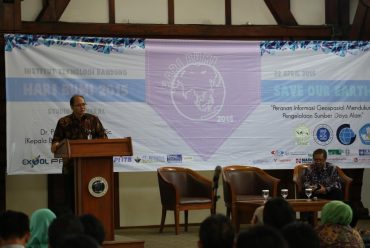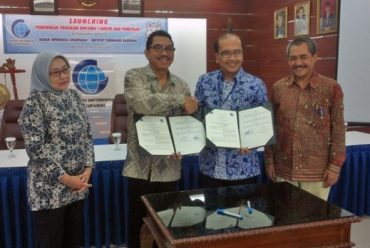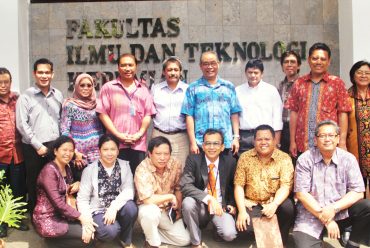Save Karst Base
Apart from the tiger’s mouth, into the mouth of the crocodile. Maybe that maxim most appropriately applied to the area with the rocky limestone karst unique morphology in Sub Base, Karawang, West Java. Apart from the large planned exploitation cement industry based in South Sulawesi, namely PT Semen Bosowa Karawang, now targeted another cement company, PT Jui Shin Indonesia.
Mid-2006, a recommendation issued by the Department of Mines and Energy of West Java province respond to the proposal of PT Semen Bosowa Karawang which would exploit the limestone area in Desa Tamansari Sub Base, Karawang for the cement industry. Department advised to look for other areas due to the proposed area is Karst Class I, according to the Classification Map Karst Region of West Java province which have been arranged in 2006.
Class I follow the Karst region of West Java Governor Regulation No. 20 Year 2006 is an area that should be protected and not recommended for cultivation activities that impair the function of the karst region. Appropriation Karst Class I is a protected area because it has a high strategic value, characterized by caves, springs, and the formation of the typical morphology (Article 13).
Utilization of the Karst Class I only can be done for activities that are not degrade the environment and biophysics. It was also in accordance with the criteria of the Karst Class I follow the Decree of the Minister of Energy and Mineral Resources of the Republic of Indonesia No. 1456K / 20 / MEM / 2000. With predetermined criteria either follow the West Java Governor Regulation and the Decision of Minister of the Republic of Indonesia, Karawang Karst Base has been designated as a Class I Karst region so it is a protected area and natural resources in the region should not be any mining activities.
Why protected? Karst is a geographical region in the earth’s surface which is characterized by distinctive shapes, such as conical hills or towers or domes with valleys rounded or oval in between. The most specific morphological features are many caves, both of which have a horizontal or vertical form.
The unique morphology is a product of the dissolution process of rocks tens of thousands of years. The process is particularly significant on the type of rock that is dissolved when reacting with water, are on limestone or limestone. In more typical leaching process is known as karsttifikasi. Karsttifikasi will be based primarily on the rock with a high content of carbonate CaCO3, layered rock landscape with a lot of cracks, occurring dynamic ground water circulation in the body rocks, and located in areas with high rainfall. Rain that falls onto the surface of carbonate rocks would seep into the body through the crack rock. During the process, rainwater, especially those rich in carbon dioxide CO2 will react with the calcium carbonate to produce the elements and acid dissolved bicarbonate. Uniquely the chemical reaction process is two-way. So the dissolved calcium will react back to form carbonate crystals back, which form stalactites and stalagmites. Processes such remarkable not necessarily take place in a short time. For example, the results ITB-Kyoto University in Gua Buniayu in Sukabumi indicate that one rod stalagmites are known to have the growth rate of only 1 cm in 25 years! Even in Gua Petruk, Kebumen, Central Java, a stalactite grows at a speed of 1 cm / 60 years! With characteristics that can store and distribute large quantities of ground water, the karst region is a source of clean water potential. Caves in addition to functioning as a path for the flow of underground rivers, caves are very beautiful ornaments and unique, making many collectors kesengsem to cut and take it home. The cave is also home to the typical plants and thousands of swiftlets and Lalay or insectivorous bats that serves as an ecological balance. Not to mention the potential cave as likely sites of prehistoric or historical, as in the Cave Pawon in Padalarang Jabar, or the caves of Gunung Sewu, Central Java, East Java, and caves throughout the world.
Those are some reasons why we should not carelessly exploit karst region.
Uniquely Karst base Geologically, Karst Base is a landscape that is formed on limestone formation Middle-Late Miocene, roughly 10-15 million years ago called Parigi Formation. Rock in the form of limestone reefs. It shows that at that time, the base is a shallow sea area is overgrown with coral reefs that flourish in warm climate conditions with clear sea water. When lifted today, reefs had been transformed into the hills with a height of 50-120 m above sea level right now.
Karst Base, as well as other Class I Karst region, have the values and sos-ek-dik-bud that can not be separated individually. This area is widespread in Tamansari village known to have many caves that have not been widely studied. Caves is a vertical cave and a hole in the ground is generally a swallow nest harvest fields with the potential to increase local community economy. There are at least 17 caves with potential swallow nest, namely Luweng Pangambuh, Cibunut, Cimiring, Narrow, Keman, Cisumur, Sitela, Gede, Sipeleng, Cileuwi, Haji, Situmeja, Silonong, Cibenda, Ja`in, Cikandil, and Cimandor. There are four cave as a hotbed Lalay, namely in Luweng Shoulders, Sikondang, Cave Lumpang, and Masigit. There are four caves where the water input and underground rivers, namely in Luweng Gede, Cibadak, Baucinyusup, and Sitamyang. A cave sacred by the locals which is in a cave shaped recess Song Paseban.
In addition, this karst region has at least two potential springs. The first is Ciburial having a water discharge more than 5 liters / sec. These springs are managed by PDAM to be distributed in Sub Base, which includes three large villages, namely Ciptasari, Castle, and Jatilaksana. Another spring though not as big as Ciburial, often found in the legs karst, for example Citaman, which became a major supplier of clean water for villages in the vicinity. The number of karst springs can not be separated from environmental conditions are still pretty forested hilly region. Of course, the sustainability of clean water will be maintained if the forest area is maintained. So it is clear how the functions of the forest, holes and caves in the ground, as well as caves in the rocks into the hydrological system that latch-hook. One element is compromised, all of them will perish.
need alternatives Under these conditions, it is definitely Karst Base classified as class I to become a protected area that should not be exploited, including for the cement industry requires 75% of its raw materials from limestone. The proposal PT Semen Bosowa Karawang in 2006 which will establish the cement industry will certainly disrupt the ecological functions Karst Base so then recommended to look for another location outside Karst Base. But suddenly appeared a small advertisement in this newspaper June 25, 2008 which announced a desire PT Jui Shin Indonesia to conduct EIA studies Mining and Cement Plant Project in Tamansari Village, Sub Base, Karawang. The same location that was proposed by PT Semen Bosowa Karawang. The ad did ask for input from the community on Karst Base exploitation plan.
There are several points of interest in response to the ad. First, the Karst region Karst Base as a Class I should not be left unharmed, somehow the process, has become the Karst Class II, which may be exploited after a through study of the environmental impact assessment (EIA). Of course this is strange, because the West Java gubernatorial in 2006 have not changed the classification map that makes Karst region karstnya Bases changed classes. Second, the ad suggests the possibility PT Jui Shin has won the authority of a permit for a cement plant plans. PT Jui Shin, as written in the ad, will build a cement plant with a capacity of 2 x 2 million tons and expected to be completed in two years. The plan will start operating in mid or late 2010. Concerning the first item above, packing this permission would have violated the West Java gubernatorial and wider Decree EMR above. Thirdly, the ad was asking for community participation in the form of advice and feedback on PT Jui Shin plans to establish a cement factory, according to SK Head BAPEDAL No. 08 of 2000 on Public Participation in EIA Process In. Outside of the legal error on the first point, and I doubt the EIA review process to be conducted, then without any impact analysis to be sure that the EIA is not required, because the Karst Karst is a Class I base that can not be exploited!
Then when the ad was asking for community input, through open writing in this newspaper, I give advice and response to such thoughts I mentioned above. In principle, seek a location outside the base Karst region, because the region is the Karst Class I. Furthermore, make alternative research to produce cement with limestone content which gradually reduces from 75% requirement to a more frugal. *** Author, lecturer in Applied Geology Scientific Group, FITB, ITB, as well as members of Indonesian Geologists Association (IAGI) and Bandung Basin Research Group (KRCB). Source: People’s Mind – Opinion, Saturday, July 5, 2008
Utilization of the Karst Class I only can be done for activities that are not degrade the environment and biophysics. It was also in accordance with the criteria of the Karst Class I follow the Decree of the Minister of Energy and Mineral Resources of the Republic of Indonesia No. 1456K / 20 / MEM / 2000. With predetermined criteria either follow the West Java Governor Regulation and the Decision of Minister of the Republic of Indonesia, Karawang Karst Base has been designated as a Class I Karst region so it is a protected area and natural resources in the region should not be any mining activities.
Why protected? Karst is a geographical region in the earth’s surface which is characterized by distinctive shapes, such as conical hills or towers or domes with valleys rounded or oval in between. The most specific morphological features are many caves, both of which have a horizontal or vertical form.
The unique morphology is a product of the dissolution process of rocks tens of thousands of years. The process is particularly significant on the type of rock that is dissolved when reacting with water, are on limestone or limestone. In more typical leaching process is known as karsttifikasi. Karsttifikasi will be based primarily on the rock with a high content of carbonate CaCO3, layered rock landscape with a lot of cracks, occurring dynamic ground water circulation in the body rocks, and located in areas with high rainfall. Rain that falls onto the surface of carbonate rocks would seep into the body through the crack rock. During the process, rainwater, especially those rich in carbon dioxide CO2 will react with the calcium carbonate to produce the elements and acid dissolved bicarbonate. Uniquely the chemical reaction process is two-way. So the dissolved calcium will react back to form carbonate crystals back, which form stalactites and stalagmites. Processes such remarkable not necessarily take place in a short time. For example, the results ITB-Kyoto University in Gua Buniayu in Sukabumi indicate that one rod stalagmites are known to have the growth rate of only 1 cm in 25 years! Even in Gua Petruk, Kebumen, Central Java, a stalactite grows at a speed of 1 cm / 60 years! With characteristics that can store and distribute large quantities of ground water, the karst region is a source of clean water potential. Caves in addition to functioning as a path for the flow of underground rivers, caves are very beautiful ornaments and unique, making many collectors kesengsem to cut and take it home. The cave is also home to the typical plants and thousands of swiftlets and Lalay or insectivorous bats that serves as an ecological balance. Not to mention the potential cave as likely sites of prehistoric or historical, as in the Cave Pawon in Padalarang Jabar, or the caves of Gunung Sewu, Central Java, East Java, and caves throughout the world.
Those are some reasons why we should not carelessly exploit karst region.
Uniquely Karst base Geologically, Karst Base is a landscape that is formed on limestone formation Middle-Late Miocene, roughly 10-15 million years ago called Parigi Formation. Rock in the form of limestone reefs. It shows that at that time, the base is a shallow sea area is overgrown with coral reefs that flourish in warm climate conditions with clear sea water. When lifted today, reefs had been transformed into the hills with a height of 50-120 m above sea level right now.
Karst Base, as well as other Class I Karst region, have the values and sos-ek-dik-bud that can not be separated individually. This area is widespread in Tamansari village known to have many caves that have not been widely studied. Caves is a vertical cave and a hole in the ground is generally a swallow nest harvest fields with the potential to increase local community economy. There are at least 17 caves with potential swallow nest, namely Luweng Pangambuh, Cibunut, Cimiring, Narrow, Keman, Cisumur, Sitela, Gede, Sipeleng, Cileuwi, Haji, Situmeja, Silonong, Cibenda, Ja`in, Cikandil, and Cimandor. There are four cave as a hotbed Lalay, namely in Luweng Shoulders, Sikondang, Cave Lumpang, and Masigit. There are four caves where the water input and underground rivers, namely in Luweng Gede, Cibadak, Baucinyusup, and Sitamyang. A cave sacred by the locals which is in a cave shaped recess Song Paseban.
In addition, this karst region has at least two potential springs. The first is Ciburial having a water discharge more than 5 liters / sec. These springs are managed by PDAM to be distributed in Sub Base, which includes three large villages, namely Ciptasari, Castle, and Jatilaksana. Another spring though not as big as Ciburial, often found in the legs karst, for example Citaman, which became a major supplier of clean water for villages in the vicinity. The number of karst springs can not be separated from environmental conditions are still pretty forested hilly region. Of course, the sustainability of clean water will be maintained if the forest area is maintained. So it is clear how the functions of the forest, holes and caves in the ground, as well as caves in the rocks into the hydrological system that latch-hook. One element is compromised, all of them will perish.
need alternatives Under these conditions, it is definitely Karst Base classified as class I to become a protected area that should not be exploited, including for the cement industry requires 75% of its raw materials from limestone. The proposal PT Semen Bosowa Karawang in 2006 which will establish the cement industry will certainly disrupt the ecological functions Karst Base so then recommended to look for another location outside Karst Base. But suddenly appeared a small advertisement in this newspaper June 25, 2008 which announced a desire PT Jui Shin Indonesia to conduct EIA studies Mining and Cement Plant Project in Tamansari Village, Sub Base, Karawang. The same location that was proposed by PT Semen Bosowa Karawang. The ad did ask for input from the community on Karst Base exploitation plan.
There are several points of interest in response to the ad. First, the Karst region Karst Base as a Class I should not be left unharmed, somehow the process, has become the Karst Class II, which may be exploited after a through study of the environmental impact assessment (EIA). Of course this is strange, because the West Java gubernatorial in 2006 have not changed the classification map that makes Karst region karstnya Bases changed classes. Second, the ad suggests the possibility PT Jui Shin has won the authority of a permit for a cement plant plans. PT Jui Shin, as written in the ad, will build a cement plant with a capacity of 2 x 2 million tons and expected to be completed in two years. The plan will start operating in mid or late 2010. Concerning the first item above, packing this permission would have violated the West Java gubernatorial and wider Decree EMR above. Thirdly, the ad was asking for community participation in the form of advice and feedback on PT Jui Shin plans to establish a cement factory, according to SK Head BAPEDAL No. 08 of 2000 on Public Participation in EIA Process In. Outside of the legal error on the first point, and I doubt the EIA review process to be conducted, then without any impact analysis to be sure that the EIA is not required, because the Karst Karst is a Class I base that can not be exploited!
Then when the ad was asking for community input, through open writing in this newspaper, I give advice and response to such thoughts I mentioned above. In principle, seek a location outside the base Karst region, because the region is the Karst Class I. Furthermore, make alternative research to produce cement with limestone content which gradually reduces from 75% requirement to a more frugal. *** Author, lecturer in Applied Geology Scientific Group, FITB, ITB, as well as members of Indonesian Geologists Association (IAGI) and Bandung Basin Research Group (KRCB). Source: People’s Mind – Opinion, Saturday, July 5, 2008








No Comments